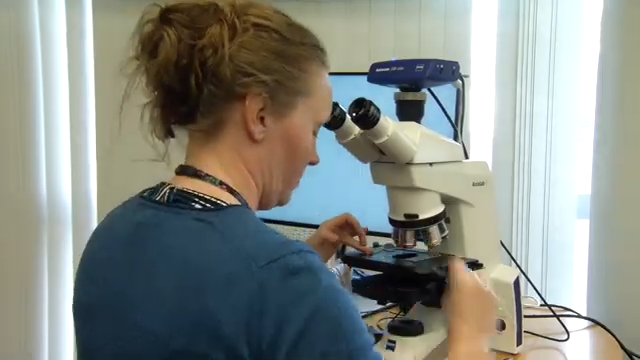LOS ANGELES, Calif. (Ivanhoe Newswire)— This year 60,000 people will be told they have pancreatic cancer. Every 12 minutes someone dies of it. Pancreatic cancer is difficult to treat and even harder to beat. In fact, by 2028 it will be the second leading cause of cancer death in the United States. But researchers have discovered a new therapy that may be able to give hope to patients.
Alex Trebek, Steve Jobs, Ruth Bader Ginsburg, Patrick Swayze, Michael Landon, Pavarotti. From the superstars to the stars of our own families, it does not discriminate.
“It is the silent killer,” stated James McReynolds.
Treatment may involve radiation, surgery and chemo, but often it is resistant to drugs. Researchers at UC San Diego and Moores Cancer Center are developing a new tumor-penetrating therapy. A peptide called iRGD is given with chemotherapy and can break through the fibrous tissue protecting the cancer.
“It kind of travels through the microenvironment. And along with that, the drugs that are co-administered can do the same,” explained Andrew Lowy, MD, Surgical Oncologist, Moores Cancer Center, UC San Diego.
In lab mice, you can see within 15 minutes of being injected with the iRGD therapy, the drugs penetrate the tumor. In a small study, the tumors stopped growing in 93% of the patients given iRGD. Fifty percent had their tumors shrink.
“That’s an unheard of number essentially in pancreas cancer,” continued Dr. Lowy.
Now a larger national study is planned in the next year.
“If everything worked out as we hope, we could get more efficacy with less side effects to achieve a better result and that would really be a home run,” said Dr. Lowy.
None of the patients in the smaller clinical trial reported any significant side effects. And this is good news not only for pancreatic cancer, but this therapy could be adapted for several other hard-to-treat cancers.
Contributors to this news report include: Marsha Lewis, Producer; Roque Correa, Videographer and Editor.
To receive a free weekly e-mail on medical breakthroughs from Ivanhoe, sign up at: http://www.ivanhoe.com/ftk
MEDICAL BREAKTHROUGHS
RESEARCH SUMMARY
TOPIC: TUMOR PENETRATING THERAPY KILLS PANCREATIC CANCER
REPORT: MB #4972
BACKGROUND: Pancreatic cancer is the 11th most diagnosed cancer in the U.S., and more than 60,000 Americans are expected to be diagnosed with this cancer in 2021. Pancreatic cancer starts when abnormal cells in the pancreas grow and divide out of control and form a tumor. When cells get old, they die, and new cells take their place, but there are times when this process breaks and new cells form when the body does not need them, or old cells do not die. The extra cells may form a mass of tissue called a tumor. A malignant tumor is called cancer. Even when the cancer spreads to other areas of the body, it is still called pancreatic cancer if that is where it originated. Pancreatic cancer often spreads to the liver, abdominal wall, lungs, bones and/or lymph nodes.
(Source: https://www.pancan.org/facing-pancreatic-cancer/about-pancreatic-cancer/what-is-pancreatic-cancer/)
CAUSES OF PANCREATIC CANCER: The exact causes of pancreatic cancer are not well understood. About 10% of pancreatic cancers are considered familial or hereditary, and a high percentage happens randomly or is caused by things like smoking, obesity and age. If a family member has pancreatic cancer, genetic testing for inherited mutations is strongly recommended. A negative result often means you do not need to get genetic testing. A person may also have a higher risk of pancreatic cancer because of long-standing diabetes, chronic and hereditary pancreatitis, race, male gender, and diets high in red and processed meats. A pancreatic tumor can be seen on a computed tomography (CT) scan, magnetic resonance imaging (MRI), or endoscopic ultrasound (EUS). Then, the doctor gets a sample of the tumor tissue to figure out the exact diagnosis.
(Source: https://www.pancan.org/facing-pancreatic-cancer/about-pancreatic-cancer/what-is-pancreatic-cancer/)
NEW PANCREATIC CANCER THERAPY: Researchers at the University of California San Diego School of Medicine and Moores Cancer Center, in collaboration with Sanford-Burnham-Prebys Medical Discovery Institute and Columbia University, studied a new tumor-penetrating therapy, tested in animal models, that may enhance the effects of chemotherapy, reduce metastasis, and increase survival. Research showed how a tumor-targeting peptide, iRGD, can sneak inside the shield that the tumor protects itself with and use the fibrous tissue as a path to reach deeper inside, destroying the tumor from within. “What is exciting about this finding is the iRGD therapy did not produce any additional side effects. This is critically important when considering treatments for patients,” said Andrew Lowy, MD, professor of surgery at UC San Diego School of Medicine and chief of the Division of Surgical Oncology at Moores Cancer Center at UC San Diego Health.
FOR MORE INFORMATION ON THIS REPORT, PLEASE CONTACT:
MICHELLE BRUBAKER
858-249-0416
If this story or any other Ivanhoe story has impacted your life or prompted you or someone you know to seek or change treatments, please let us know by contacting Marjorie Bekaert Thomas at mthomas@ivanhoe.com




